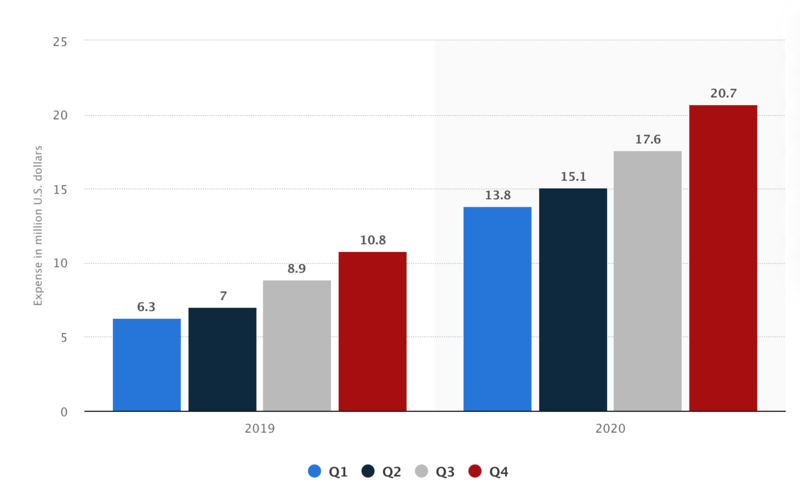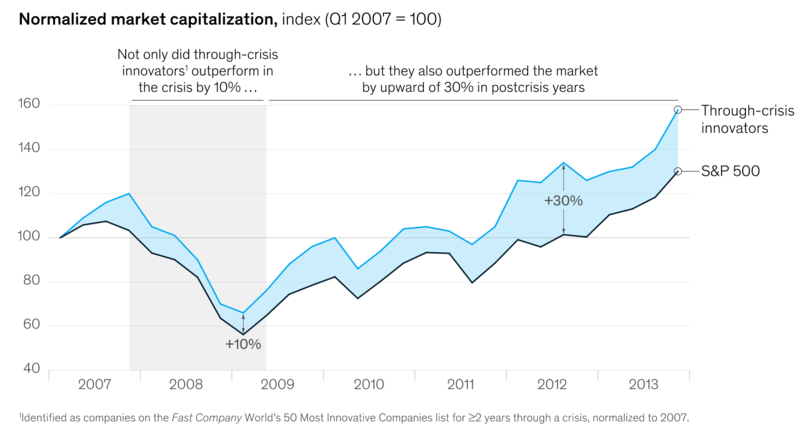“Should we invest in R&D now?”
“Is it a good time to create new websites, apps, or improve the ones we have?"
This is the state of mind of many CEOs, growth leaders, and innovation managers from around the world. With the global pandemic showing no signs of stopping, investing money and resources in new digital solutions seems a bit risky.
Not an easy decision, indeed. What makes this even more interesting is the fact that many innovative businesses are winning big. Think about it:
-
eCommerce. Online sales are growing at an unprecedented rate
-
Cybersecurity. The global market increased by 9.7 percent in the Q1 of 2020 (these folks are selling their products like crazy)
-
Cloud SaaS. Remote work requirements are fueling tremendous growth in companies selling software for online document processing, video meetings, and collaboration.
So, both SaaS providers and eCommerce sellers are expanding and solidifying their market positions. It’s easy to imagine that your competitors are doing the same.
The purpose of this post is to:
-
Give you an overview of how other innovate during the pandemic
-
Explain why innovation is critical for business growth at this time
-
Summarize the innovation platform method.
COVID-19 Crisis: Opportunity for Growth?
Many businesses have ceased investments in the development of new digital products and R&D. A reasonable decision, right? Yes. But at the same time, a lack of innovation also puts them at risk.
Why keep investments in innovation in crisis? Here are a few reasons.
Reason 1: Adaptation to Customer Behavior Changes
Customer needs continue changing regardless of circumstances.
Medical centers, for example, now have to provide telemedicine services to their clients. Many others have also suffered a great in-person engagement.
Zoom is the best example of success, though. In a matter of months, the company had to adapt its product to be more usable by individuals. Before that, they were more focused on corporate users.
How much has Zoom been spending since the pandemic began, you ask? Here you go.

Zoom's quarterly research and development (R&D) expense worldwide. Credit: Statista
The result? A 169 percent revenue increase in the first quarter of 2020.
Reason 2: Finding New Growth Opportunities
Many eCommerce, cybersecurity, and SaaS providers have addressed new growth opportunities brought about by the pandemic. For example, custom software development companies have been busy as small businesses discovered opportunities to sell more via websites.
Many had to invest in changing their websites. The folks at a California-based Ordinaire wine shop, for example, had to re-design their online shopping experience. Specifically, they’ve added:
-
An expanded order form where customers can give wine preferences
-
More features in the delivery window (they’ve used to have only pickup option)

These changes are the result of finding more opportunities to sell. Now, shopping at Ordinaire is much easier, which is critical to their survival.
Reason 3: Ensuring Post-Crisis Growth
Customer buying preferences and behaviors have changed, and many of them will remain post-pandemic. For example, many will continue to buy more products online, including those they used to get in brick-and-mortar stores.
McKinsey supports this in their latest “Innovation in a Crisis: Why it is More Critical Than Ever” report. Accordingly, companies that continued innovation through the 2009 financial crisis had a better understanding of shifts, opportunities, and challenges. In fact, they performed 30 percent better than their market average post-crisis.

Credit: McKinsey
Faster recovery in the post-crisis period is therefore an opportunity for those who continued to innovate.
But does it mean investing in new R&D projects like before?
Not exactly. To reap the benefits you’ve just read about, companies need a slightly new and better approach: innovation platform.
Let’s talk about it next.
Innovation Platform: a Safe and Effective Way to Innovate During Crisis?
Innovation platform is a strategy for building and testing new software ideas.
In other words, it’s a place where both developers and non-developers gather to discuss new technical solutions, prototypes, features, tools to allow the company to grow faster.
“Does it mean a room where folks meet to discuss software ideas?”
No.
It’s not just a “meeting,” it’s a software and business solution in one, the purpose of which is to enable fast brainstorming, prototyping design, and testing of digital business products for growth.
What does all of this have to do with innovation? By adopting the innovation platform strategy, companies become innovation-driven, as R&D processes and growth hacking becomes a top agenda item.
To create something that brings revenues fast, innovation platforms advise a step-by-step process.
How Does Innovation Platform Work?
There are three main stages that streamline innovation processes.
A company:
-
Collects and chooses the best ideas
-
Develops and tests prototypes
-
Puts ready-made solutions to use.
The first two steps are done in the innovation platform. Let’s take a close look at how a business like yours can benefit from doing so.
1. Idea Collection & Brainstorming Stage
The purpose here is to bring all folks working at your company together and give them a place to talk, generate, and submit ideas. A new app feature, a more customer-friendly order form, website update - everyone can contribute.
But that’s not all. Innovation platform software comes with prototyping tools for non-designers. This means that the folks from marketing, customer support, and other departments can easily make prototypes without coding and design skills!
Ultimately, the best ideas are discussed and moved to the next stage.
2. Prototype Development and Testing Stage
As soon as the management gives the green light to produce working solutions based on ideas, prototype development begins. This time, it’s the developers and designers who do the work.
A specially assigned innovation project team works with every business idea using a highly structured lean process. As a result, the time to create a ready-for-testing prototype is significantly shorter compared to traditional methods.
Ultimately, companies get the Minimum Viable Product (MVP) quickly, and use them for business purposes.
3. “Put Business Solutions to Use” Stage
At this point, there’s nothing left to do but try the new digital solution in practice. Monitor its impact on business for some time and evaluate how customers interact with it.
Innovation Platform: The Bottom Line
So, should you invest in R&D during the crisis?
Yes, but you need to be smarter about it. To make the innovation process faster and more standardized, consider using innovation platforms. They give your employees a place to “meet,” brainstorm, prototype, and test digital solutions you need to grow.
Continue making investments in growth despite the pandemic. If the cases of many companies proved anything, it’s that innovation isn’t only possible, but a requirement for major business growth, higher revenues, and post-crisis recovery.

